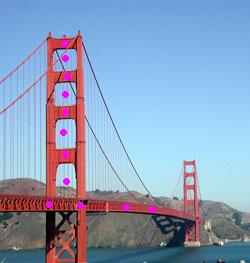xcavator.net visual image search, update
A few days ago I received an e-mail from Lenny Kontsevich, CTO of Cognisign. They run xcavator.net (an unfortunate choice of name…) which is a visual image search site. Dr. Kontsevich expressed his disagreement with the review of their application in our wiki. The review is just three short sentences describing the application and my experience with it:
xcavator.net: Semi-manual search based on recording the color at key points chosen by the user. Seems like a good idea, why doesn’t it work? Experiment: an image of rose with 20 key [points] returns an image of a girl in a red bikini.
I want to describe exactly where this came from and give an update.
When I tried the application last year, it seemed that the approach to image matching and search was the following: by placing key points on the image you help the computer concentrate on the important parts. The computer can match images by studying them as a whole; for example, using the color histogram of the image. However you may be interested in matching only a part of the image in order to find different images depicting the same object. Then you need to have the capability for the user to select that object or a part of it. That’s the way I understood this application.
First, I watched carefully the video introduction. The sample image they showed was the Golden Gate Bridge and they put points in the right parts of the bridge: the metal parts of the frame and the holes in the frame. The end result was a series of very good matches of the bridge. The reason was that the points (less than a dozen) were chosen so well that there may be no other image that would have pixels of those colors located the same way with respect to each other. This approach made perfect sense to me.
Next I followed the instructions exactly. I picked an image of a flower and placed key points around the center (red) and in the middle (black). The result was a few red roses but at the same time each time I added a point to the original (10, then 20) one image would never disappear among the matches. It was the image of a girl in a red bikini.
Clearly that was not supposed to happen. The colors were matched but not the locations of the colors. My conclusion was that either this was a bug or I simply misunderstood the method.
This experiment was what I reported in the blog (more than a year ago!). Later I also copied the report to the wiki. Unfortunately, the word ‘points’ in “20 key points” was lost. That may give (and it did) the impression that I chose 20 key words. The meaning changes completely. The review was also copied without the date. That may also have contributed to the misunderstanding because since then many things have changed. There is no Golden Gate Bridge anymore in the introductory video. It seems that the whole application is now much less about matching color+position and more about colors alone and especially tags.
The instructions still mention shapes. Repeating my experiment I didn’t get the girl in a red bikini this time. However I was unable to evaluate how much shapes contribute to image matching. The reason is that the matches are made firstly on the base of the color and on the base of tags. You would never know whether the match was based entirely on colors and tags or on shape as well. There is no image upload and that’s what prevented me from testing in any further. This situation is not uncommon in this area. There are also no links that would help you understand how things work and I was not about to engage in “investigative reporting”.
Of course I’m biased here - I simply do not care about matching based on colors. What I am interested in is the image search technology that is independent of color and of course independent of tags. In some areas, such as radiology, all images are gray scale. That said, the purpose of xcavator.net is to help customers to search those huge collections of stock images. That seems to work fine.
The review of course will have to be updated.
Digital discoveries
- Casinos Not On Gamstop
- Non Gamstop Casinos
- Casino Not On Gamstop
- Casino Not On Gamstop
- Non Gamstop Casinos UK
- Casino Sites Not On Gamstop
- Siti Non Aams
- Non Gamstop Casinos UK
- UK Casino Not On Gamstop
- Non Gamstop Casino UK
- UK Casinos Not On Gamstop
- UK Casino Not On Gamstop
- Non Gamstop Casino UK
- Non Gamstop Casinos
- Non Gamstop Casino Sites UK
- Best Non Gamstop Casinos
- Casino Sites Not On Gamstop
- Casino En Ligne Fiable













